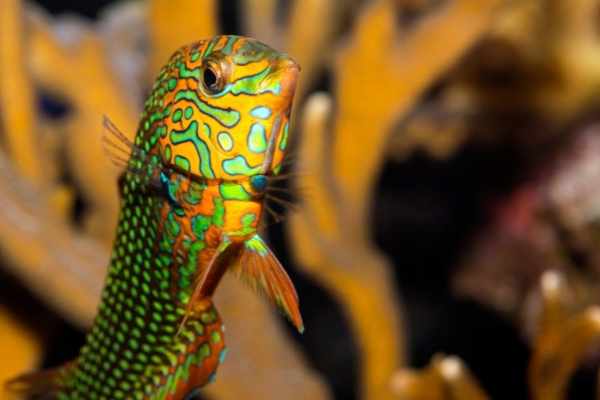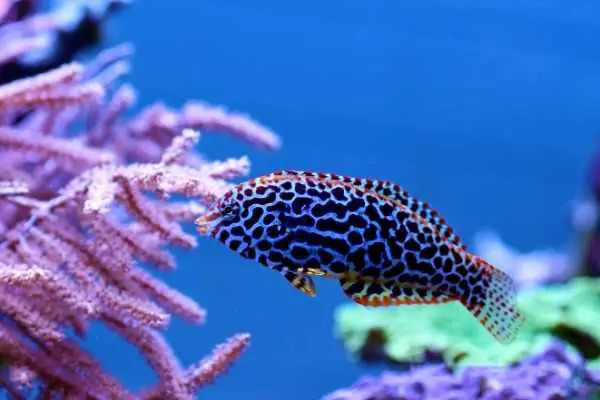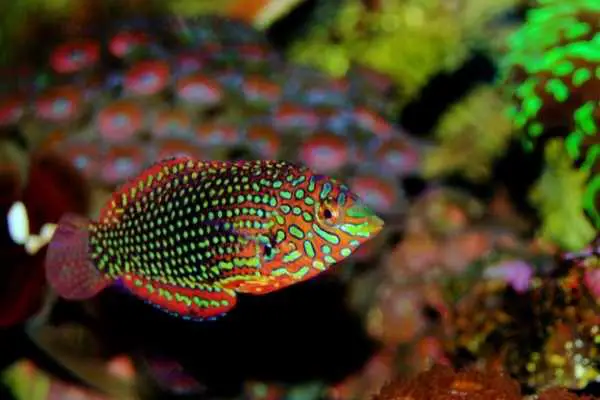Leopard wrasses (Macropharyngodon spp.) make colorful and active additions to any reef tank. They’re also helpful for anyone struggling to protect their Tridacna clams from troublesome pests. But all of those positives come with STEEP care needs. And unless you have plenty of experience under your belt, you’re probably better off admiring these beauties from afar.
Table of Contents: Leopard Wrasse Care
Anyone looking to take on one of the leopard wrasses should read through this entire article to make sure they don’t miss out on anything important. However, if you’re searching for a critical component, you’ll find links to their individual needs below:
- Quick Facts
- Description of the Leopard Wrasses
- Leopard Wrasse Lifespan
- Creating the Ideal Leopard World
- Leopard Wrasse Diet
- Leopard Wrasse Behavior and Tank Mates
- Breeding the Leopard Wrasse
- Pros and Cons
- For More Information
Quick Facts
- Common Names: Leopard wrasse, Guinea fowl wrasse, Black-spotted wrasse, African leopard wrasse, Choat’s wrasse, Vermiculate wrasse, Splendid leopard wrasse, Potter’s leopard wrasse, Yellow-spotted leopard wrasse, Ornate leopard wrasse, Geoffroy’s wrasse
- Scientific Names: Macropharyngodon bipartitus, choati, M. geoffroy, M. meleagris, M. negrosensis, M. ornatus
- Size: 4-6 inches (10.2-15.2cm)
- Minimum Tank Size: 100 Gallons (378.5L)
- Reef Safe? Yes
- Care or Experience Level: Expert
- Preferred Diet: Carnivore
- Original Part of the World: Indo-Pacific

Description of the Leopard Wrasses
As you might guess, leopard wrasses have a spotted pattern over their scales. It’s one-half of the reason for their names. But they also stalk their favorite prey items, and that long, slow “crawl” after their targets put people in mind of the same big cats they share a name with. So did their habit of remaining shy and reserved, hiding out from divers along the reef. Put the spots and behavior together, and you get the leopard wrasses.
Colors vary across the species, though you find two things in common:
- All of these members of the Labridae family exhibit sexual dichromatism. In other words, males and females have different color palettes.
- They’re also protogynous hermaphrodites with the potential to undergo three different color phases throughout their lives.
For the most part, males use an orange or red background for their spots. You can then find spots in every range from green to mauve to blue. The exceptions are the black leopard wrasse with a dark background and the Choat’s wrasse, which uses a silver underlay.
In contrast, females use white as their primary color. And their spots usually stay in the range of brown or black – sometimes with a thin highlight of blue. It doesn’t make them any less stunning against a coral reef, but it DID cause confusion when scientists first stumbled upon these labrids. They started classifying the two sexes as separate species!
You also have to consider life phases when you look at a leopard wrasse:
- Juvenile phase: These are fish that are sexually immature. And since all leopard wrasses are born female, you’ll find the female coloration.
- Initial phase: Colors brighten here as the females become sexually mature.
- Terminal male: More appropriately, these are secondary males. It’s what happens when the most dominant female becomes a male in a harem.
How big does the Leopard Wrasse get?
The Leopard Wrasse grows to a maximum size of 6 inches (15 cm).
Leopard Wrasse Lifespan
Leopard wrasses live throughout the Indo-Pacific region. They stretch as far as the Red Sea and even around the waters of Hawaii (well, Potter’s leopard wrasse does, anyway). They prefer reef environments where they can stalk their prey – and dash for cover in the seafloor when a threat looms near.
In the wild, they live for up to 10 years. It’s a figure that many aquarists aspire to. But given the difficulty associated with their keeping, most of these spotted fish don’t make it more than five years. And plenty of leopards never even make it out of the fish store in the first place. The stress of transport across multiple time zones, without regular feedings, in a plastic bag is too much for them.

Creating the Ideal Leopard World
The majority of the leopard wrasse species prefer to hang out in pairs along reefs throughout the Pacific and Indian oceans. You may also glimpse small schools of females. It takes a diver as patient and stealthy as a leopard to creep up on a male. While predators in their own right, these fish have a flight reaction to dive into the sand when frightened. And they can remain there for DAYS.
You’ll need to replicate that safe retreat, too. Not because you plan to house your leopard wrasses with potential predators, but because they bed down in the sandy substrate for the night. Leopards are one of the most timely fish you’ll ever encounter. They settle in to sleep and wake up at the exact time every day. (You can set your watch by them!) And burrowing into the sand also figures in their grazing habits.
This means providing a deep bed of at least two inches in depth. Your sand choice is essential, though. You want a fine grain of rounded sand to protect your leopards from damage to their scales. If you can find sugar-fine aragonite sand, that’s your best option. And while the fish store may assure you you can use a tray of sand in your reef tank, that won’t keep a leopard wrasse happy. You want to fill the bottom of the tank with the substrate.
Leopard wrasses spend their days hunting for appropriate food sources. This means you also need to supply forage material. To keep these delicate (and picky – but we’ll get to that) fish happy, your tank needs a MINIMUM of 100 pounds of mature live rock. The rock will allow your leopards to feed, explore, and feel safe, all at the same time.
Besides, think how fantastic those spots and colors will look, set against a rocky background.
Does a Leopard Wrasse need sand?
A fine grain sand bed of 2 inches or more is recommended to recreate sufficient room for this fish to feel secure and burrow. Keeping them in a bare bottom tank is possible, but that environment would not provide for an important habitat and natural behavioral need to bury themselves at night.
Leopard Wrasse Tank Size
At a maximum, leopard wrasses don’t get larger than 6 inches (15.2cm). But if you’re hoping to keep your spotted beauties happy and healthy, you need a MINIMUM of a 100-gallon (378.5L) marine tank. This provides the room you need for all of that live rock, the sand bed they want for burrowing, AND the space they need to swim and explore.
If you attempt to go smaller, you’ll end up stressing your fish. And leopards in fish stores have already undergone high levels of stress. You want to introduce new fish to a system that’s cycled and prepared for them. If you do so, you’re less likely to watch your new purchase struggle and pass away within a few days or weeks.
You also need a proper lid on your reef tank. And you may want to consider dropping the water level a couple of inches below the cover. Leopard wrasses have a STRONG fight or flight instinct – with emphasis on the FLIGHT. When they startle, they’ve been known to launch out of the tank. And they’re small enough to get out of narrow openings. You’re better off preventing an accidental escape.
Are Leopard Wrasses Reef-Safe?
Pairing up the colors and patterns of the leopard wrasse with a reef tank leads to a stunning display. And you’re in the clear with that plan. Leopards are completely reef-safe. While they forage around the live rock and burrow in the sand, they have no interest in corals. And as they swim throughout the tank, they’re careful to avoid any rocky structure to protect their scales.
Many aquarists who frag their corals include leopard wrasses in their tanks due to the fish’s peaceful behavior around polyps. And leopards are champs at routing unwanted pests from marine tanks. They have large teeth on both sides of the upper jaw, as well as prominent canines. The teeth make them adept at feeding on mollusks. In particular, they hunt down the snails that target Tridacna snails. They even outrank the six-line wrasse at the task!

Are Leopard Wrasses hard to keep?
The gorgeous Leopard wrasse is a challenging fish to care for in a saltwater tank. Acclimation to aquarium life is often met with challenges to get them to eat. Since they are wild-caught, the individual you purchase may also have debilitating parasites as well. Caution, quarantine, and careful attention are recommended when introducing them to your system.
Leopard Wrasse Diet
Feeding leopard wrasses is where many aquarists struggle. Which is strange as they should be a piece of cake! They’re carnivores, preferring to route copepods and other invertebrates from the reef environment. But anyone who’s watched their leopards swallow a bite, only to spit it out again, will attest to these fish being genuine problem children.
Part of the problem is the short digestive tract of the leopard wrasse. They’re active fish, and large meals would slow them down. Instead, they have small stomachs that allow them to move at a quicker pace. But that means they need to eat more often. A leopard fed only a couple of times a day will quickly starve. You need to feed them AT LEAST 4-5 times a day. Having a refugium attached to your reef tank will help you.
The types of food are easy to find and keep on hand. Leopards LOVE copepods and will often erase a tank of any they find. Otherwise, you want to look for live or frozen proteins they can forage for. The best choices include:
- Black worms
- Brine shrimp
- Chopped shrimp
- Mysis shrimp
You CAN train them to accept commercial foods, as well. But you’ll need to pair the flakes or pellets with those favorite protein choices to create the association. And don’t think you can convince your leopard wrasse to take the commercial food in place of a live food offering. They’ll starve themselves first.
The picky nature of this fish – and the frequent feeding schedule – often leads to the early demise of these spotted fish. If you’re not up to the task, consider another species that isn’t such a handful.
Do Leopard Wrasse eat pods?
A Leopard Wrasse will hunt for and eat copepods (aka. ‘pods’) in a mature reef tank.
Leopard Wrasse Behavior and Tank Mates
Leopard wrasses exhibit unique behaviors that make them appealing to aquarists – in addition to those patterns and colors. Not only can they “tell time” and set their schedule for sleeping and waking, but they also have a rudimentary understanding of time zones. This is why leopards often remain buried for the first few days in a new tank. They’re not frightened – they’re trying to adjust away from “Island Time.” The time spent in the sand allows them to sync their circadian rhythm to the pattern of day and night you’ve set up in the tank.
They also establish routines within a tank, returning to the same foraging spots over and over. This can help you if you find yourself struggling to get a new acquisition to eat. But give them a little time to wake up, first. Leopards often appear aimless for the first 10 minutes after emerging from the sand in the morning. Similar to your need for coffee and a chance to shake off your previous night’s sleep, they’re getting their morning jump-start.
If you notice your leopard wrasse performing a “dance” in the marine tank, pay close attention. This strange swimming pattern is meant to frighten potential predators. And it means someone else in the tank poses a threat (real or imagined). Of course, the dancing of this spotted fish rarely causes a predator to feel threatened. More than likely, they pause in their crouch out of confusion. But it’s usually enough time for the leopard to dash for the sand. You should probably skip larger, aggressive species just to be on the safe side. Remember, leopards and stress don’t mix. As such, the following fish DON’T make good tank mates:
- Frogfish
- Groupers
- Puffers
- Scorpionfish
- Soapfish
- Toadfish
- Triggerfish
- Waspfish
You also want to skip other fans of copepods. Not because of their size, but because of the shared diet. Leopard wrasses are too fast and determined to strip a tank of copepods. So dragonets (for example) often end up starving.
You can get away with keeping a school of leopard wrasses, provided you introduce them to the aquarium at the same time. And you want to avoid more than one male per tank – unless you plan to dedicate an entire household to the tank size. They’ll fight with one another to take over the females and create a harem. A group of females will do fine with each other (and you’ll probably end up with a terminal phase male, anyway).
If you want to create a wrasse tank, choose species that come in smaller than the leopards. Otherwise, you may see problems emerge. They’re not the happiest with others from their family, and you WILL see aggression, especially if the two look similar.
Leopard wrasses are generally incompatible with other members of the wrasse family including cleaner wrasse, coris wrasse, melanurus wrasse, six line wrasse, and fairy wrasses.
Breeding the Leopard Wrasse
Due to the sexual dichromatism, it’s easy to figure out whether you have males or females in your tank. And even the phase changes are simple to pick out. Terminal phase males are much larger, with more brilliant colors. And they have a shyer personality than the females. When a female shifts, the change takes around two weeks to complete. However, the body starts producing sperm within a few days.
But there’s a slight wrinkle: you can see PRIMARY males among leopard wrasses.
A primary male happens rarely. These fish are born males. Their colors are even more intense than what you see in terminal phase males. (Remember, they’re also called secondary males) Otherwise, to tell the difference between the two, you need to look at their testis. Fine if you’re performing a necropsy, but not practical for breeding purposes.
Then again, the odds that you’ll breed your leopard wrasses are low. They require an elaborate courtship ritual that most hobbyist reef tanks can’t accommodate. In the wild, a male will approach a group of females. Diving down, he’ll execute repeated dives to the seafloor. Any females with eggs will then follow with rapid, vertical jumps out of the water before settling mid-way in the water column. The two then meet up, bolt up a few feet, and then split and release the eggs and sperm.
It’s a dramatic dance, but it’s difficult to replicate in a captive setting. And as most aquarists don’t want to risk their leopards ending up on the floor, no one tries to encourage the practice.
Pros and Cons
Leopard wrasses are one of the most difficult tropical species to manage. And even if you have your heart set on bringing them home, you need to carefully consider the pros and cons.
Pros
- As leopard wrasses bury themselves in the sand, they rarely develop external parasites. The sand prevents the pests from attaching to the fish as they sleep at night.
- With the adaptation of their upper teeth and canines, leopards happily remove pest snails that often feed on Tridacna
- While they do forage over live rock throughout the day, leopard wrasses don’t like to bump into, touch, or feed on coral structures, making them 100% reef-safe.
Cons
- Leopard wrasses get collected from the wild, and transportation in plastic bags without sand in the bottom often leads to stress and early death.
- During transportation, the fish struggle to bury themselves in non-existent sand, leading to damage to their mouths, impairing their ability to eat.
- Leopards are often difficult to get to eat, and they may starve if you don’t provide 4-5 feedings of the appropriate proteins they need.
For More Information
Even if the tricky nature of leopard wrasses has put you off from adding one to your reef tank, you probably still want to learn more about them. After all, they’re gorgeous fish!
This YouTube video shows leopard wrasses swimming through a reef tank (to demonstrate they’re not the horrors to keep that people think):
Want to learn more about the best leopard wrasse tank mates?
- Banggai cardinalfish
- Blue tang
- Copperband butterflyfish
- Flame angelfish
- Gem tang
- Midas blenny
- Powder brown tang
- Sailfin tang
- Starry blenny
- Yellow tang
Do you want to make sure you’re prepared to care for a leopard wrasse properly? Let’s review some key components you’ll need:
Conclusions
Leopard wrasses look stunning. And how often can you set your watch by a fish? They’re unique species. But they’re also challenging. You’ll want to make sure you’re at the top of your fishkeeping game before you decide to bring one (or a school) home. Once you’ve mastered their feeding schedule, though, you’ll wonder how you ever did without them.
References
- Burgess, W.E. et al. 1990. Burgess’s Atlas of Marine Fishes.
- Delbeek, J.C. and Sprung, K. 1994. The Reef Aquarium.
- Debelius, H. and Baensch, H.A. 1994. Marine Atlas.
- DeLoach, N. 1999. Reef Fish Behavior.
- Fenner, B. 2011. “Leopards of the Reef.” Tropical Fish Magazine.
- Lieske, E. and Myers, R. 1996. Coral Reef Fishes.
- Scott, M.W. 1992. A Guide to the Leopard Wrasses.


Leave a Reply